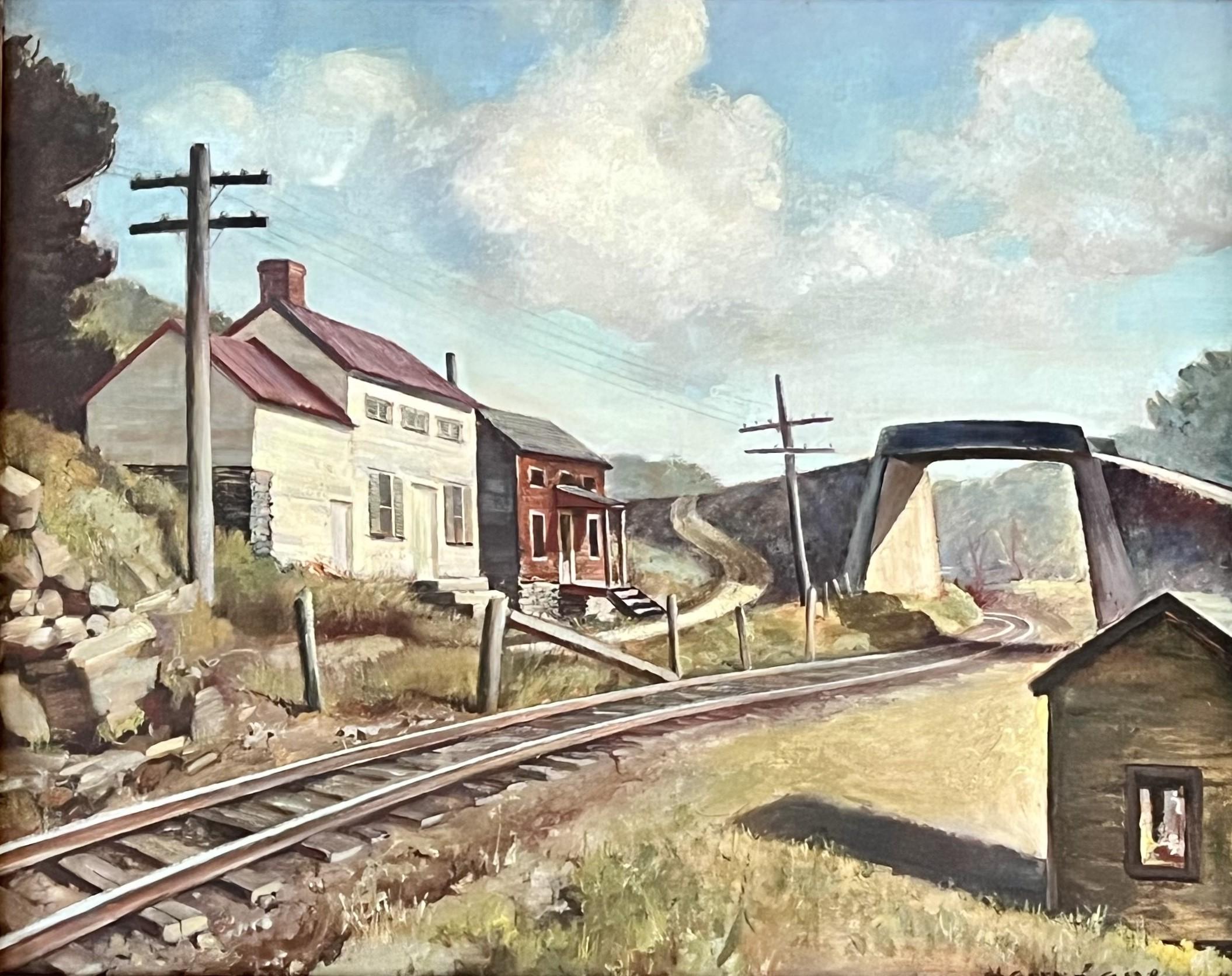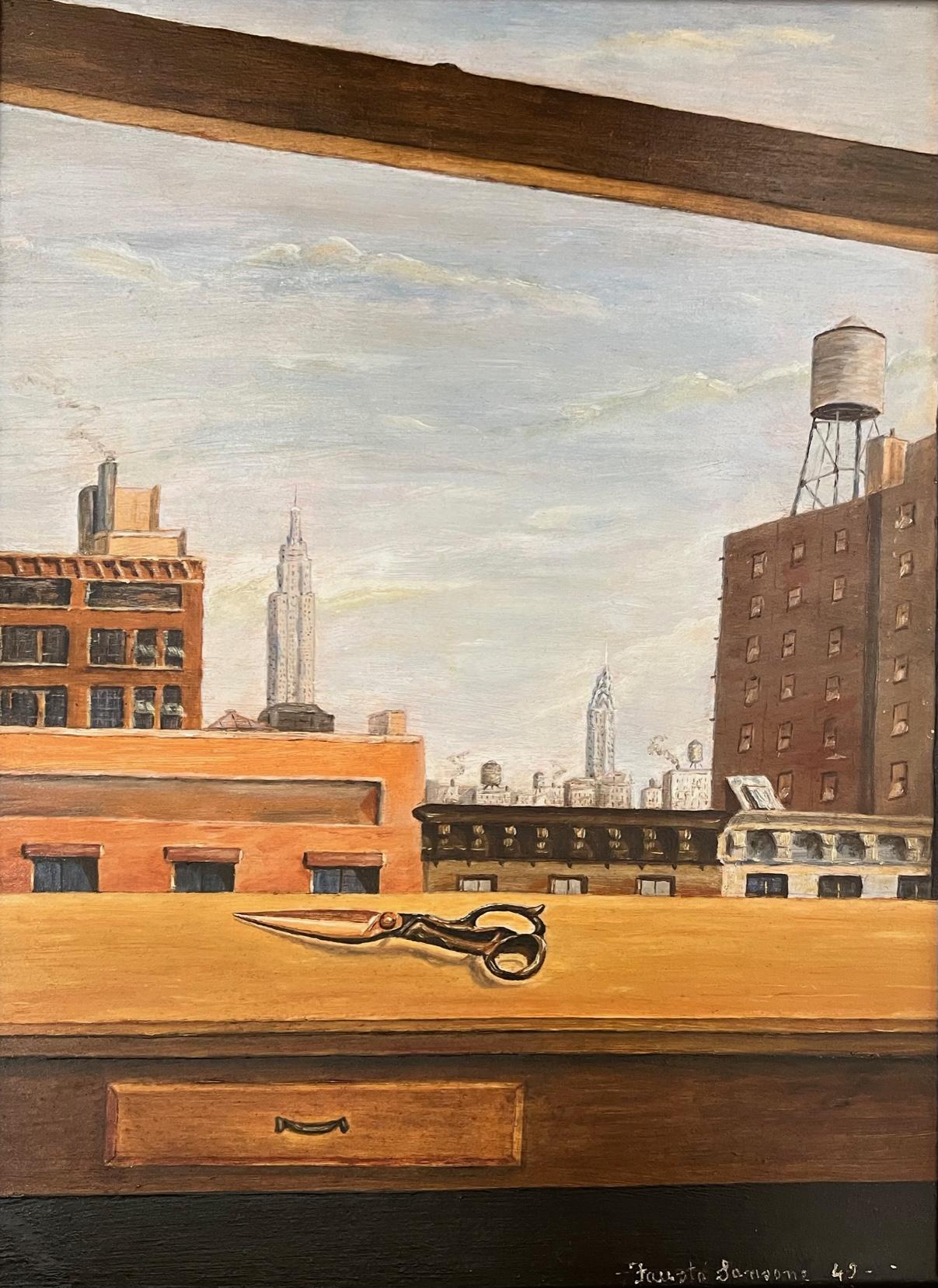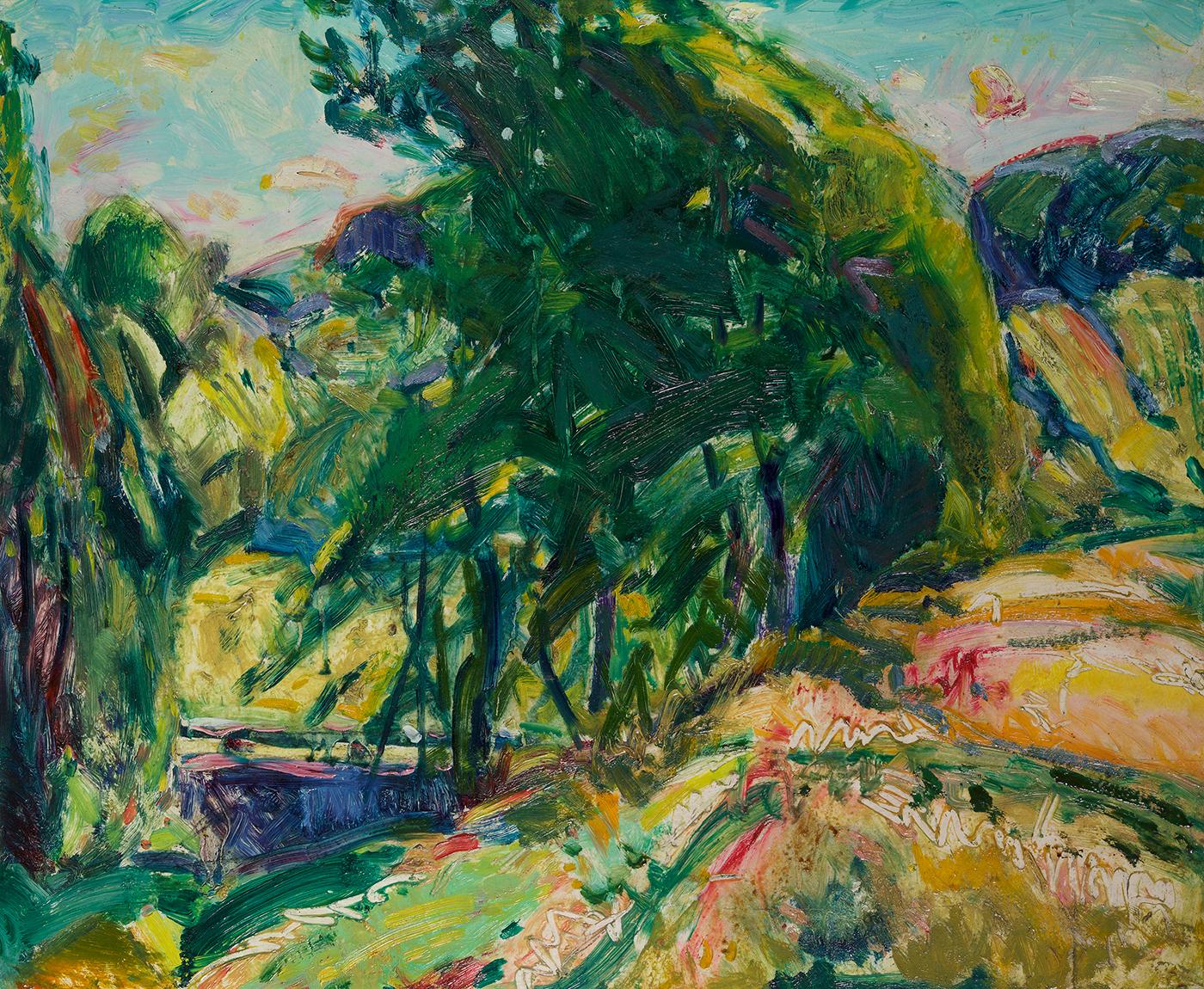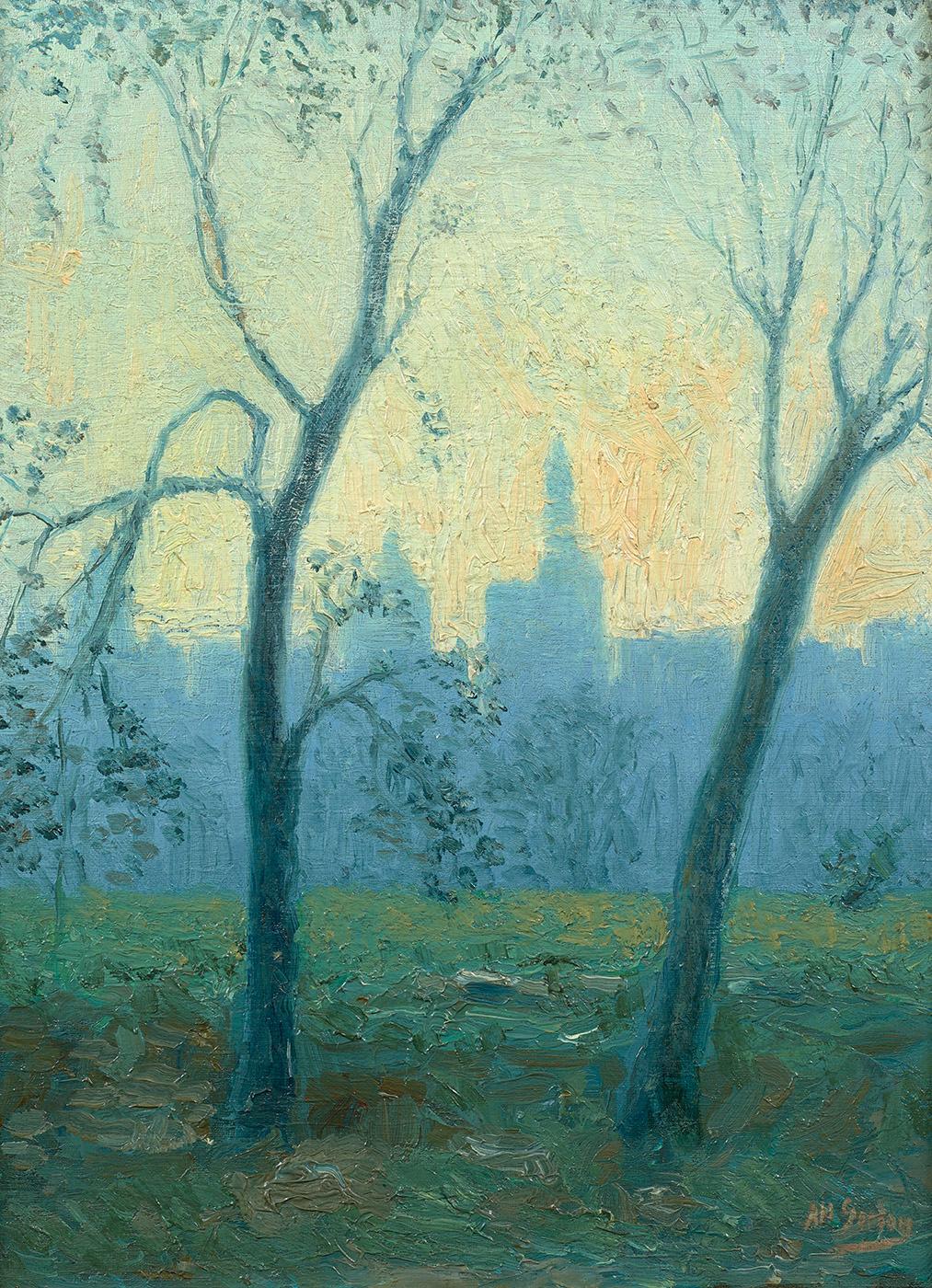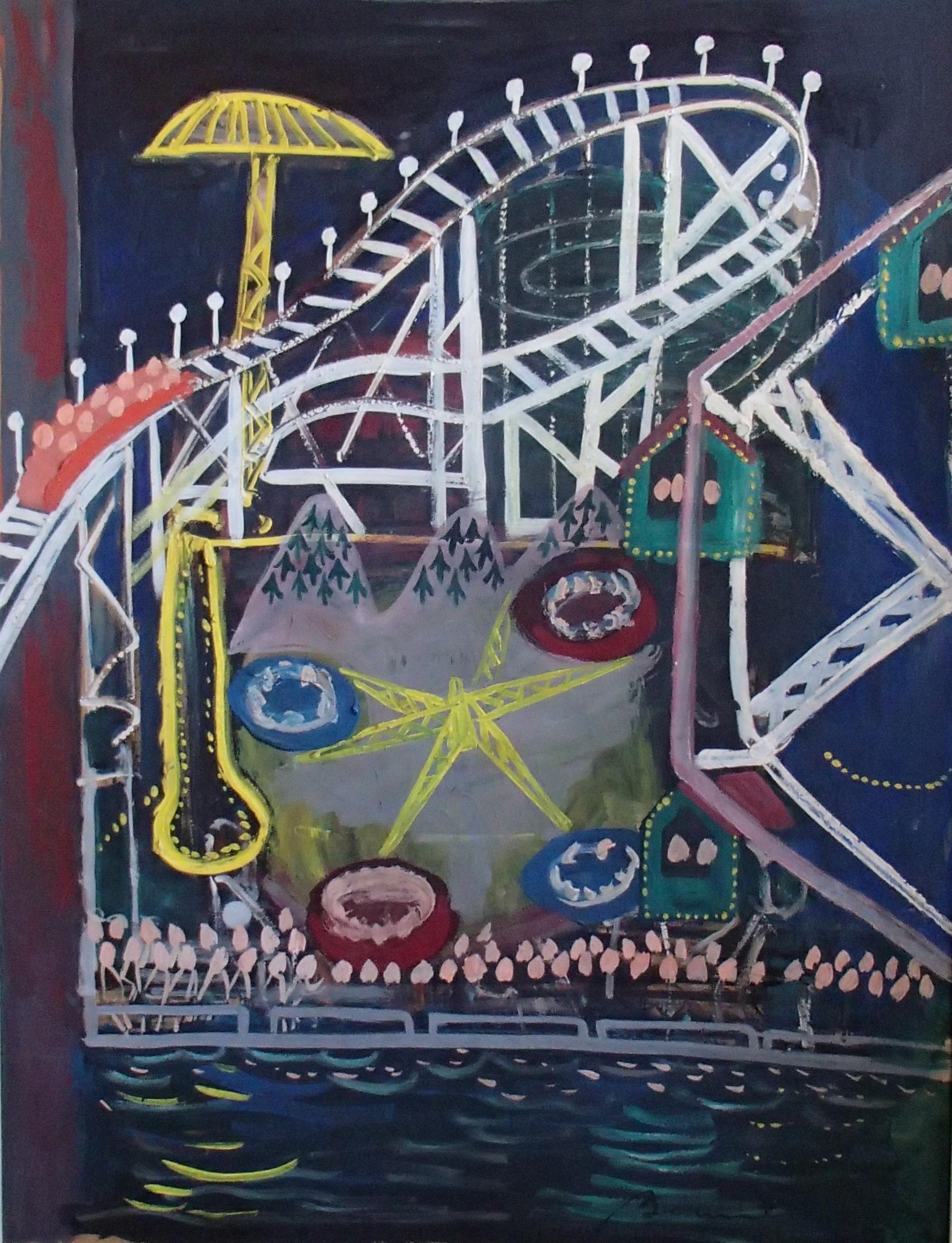Items Similar to Evening Landscape in Late May, 1970s Yorkshire Landscape, Oil on Board, Signed
Want more images or videos?
Request additional images or videos from the seller
1 of 7
Raymond BoothEvening Landscape in Late May, 1970s Yorkshire Landscape, Oil on Board, Signed1974
1974
About the Item
Oil on board, signed and dated '1974' lower right
Image size: 31 x 48 inches (79 x 122 cm)
June 1987 Exhibition label on verso
Original frame
Provenance
The Artist's Estate
Exhibited
"Raymond Booth, A Memorial Exhibition", The Fine Art Society, London, 12th August - 9th September 2016, no.62
"Raymond Booth, In the Wild", The Fine Art Society, London, 02 May -29 May 2017, No. 11
Booth was above all a great recorder of the natural world who could translate his observations of the Yorkshire countryside, its fauna and flora, into compositions of a beauty and intensity rivalling the greatest of his Victorian predecessors.
This intense, yet intimate, landscape depicts a section of woods around Booth's home in Alwoodley, Leeds, where he spent much of his time. Here Booth has worked slowly to develop the densely worked, close-up, landscape in which the woodland and meadows have acquired a poetic quality through his sensitivity to season, weather and time of day.
Raymond Charles Booth
Intensely private, and possessing an obsessive work ethic and passion for the natural world, Raymond Booth earned a reputation as one of the greatest botanical painters and illustrators, despite rarely leaving his Yorkshire home. Eschewing the more fashionable modernist principles of the early mid-twentieth century, he instead produced beautiful, intense compositions in oil of British flora and fauna, that rival the very finest Victorian followers of the genre.
Raymond Booth was born in Wetherby, West Yorkshire, on 8 August 1929, to John Booth, a member of the local police force, and his wife Margaret Edna. When Raymond was still a young child, the family moved from their first home in the crowded streets of central Leeds, to Fearnville Place, in the leafy suburb of Roundhay. His father was a keen rambler and impressed upon Booth from an early age a respect and understanding for the British countryside. Just a short walk from his childhood home was Roundhay Park, the second largest urban park in Europe, comprised of over 700 acres of parkland, lakes and woodland. It is likely that growing up so close to such an environment had a profound influence on him, helping to develop what would become a lifelong obsession with natural world. Booth’s early passion for nature was surely heightened by the number of summer holidays he spent on an estate near Winterslow, Wiltshire, where an uncle worked as a gamekeeper.
In 1946, at the age of 17, Booth won a scholarship to study at Leeds College of Art. However, his studies were put on hold during two years of National Service, which he spent largely with the RAF in Egypt, guarding the Suez Canal. He returned to Leeds College in 1949, graduating in 1953. While at Leeds College, he had frustrated his teachers and fellow students by insisting on working in a more traditional, precise style, and rejecting the more Modernist principles that were being promoted. As a result, his teachers convinced him that he was unlikely to earn a living as an artist, and encouraged him instead to study for a teaching diploma. Shortly after graduation however, he was diagnosed as suffering from tuberculosis, a consequence of his time in Egypt, and was admitted to a sanatorium, where he would stay for the next six months. Years later, Booth would joke ‘I am one of the few people who can say, “Thank God for TB”’ (The Times obituary, 9 September 2015), as his months of recuperation gave him countless hours to develop his skills as a botanical artist. This enforced focus on his work gave him the confidence to submit a number of his drawings to a botanical art exhibition in London organised by the Royal Horticultural Society. These works attracted the attention of a number of prominent horticulturalists, including Dr Harold Fletcher, the director of the RHS’s gardens at Wisley, Sir George Taylor, director of the Royal Botanic Gardens at Kew, and the second Lord Fairhaven, all of whom would become patrons of Booth. His drawings at the Royal Horticultural Society also earned him a commission to illustrate a large two-volume work devoted to camellias, entitled The Camellia (1956), by Beryl Leslie Urquhart. When the actor Ernest Thesiger viewed the works at the RHS, he recommended them to the director of Walker’s Galleries on New Bond Street. As a result, Booth would exhibit there until its closure in 1961.
Following the closure of Walker’s Galleries, Booth began exhibiting, from 1962, at the Fine Art Society. He held is first solo show there in 1975, and would go on to have a further seven dedicated exhibitions, including a large, 50-year retrospective in 2011. Though he lent several owl studies to an exhibition on birds of prey at Leeds City Museum during the early 1970s, he remained virtually unknown in his native Yorkshire until a retrospective exhibition of his work toured his home county, going on display at Huddersfield Art Gallery, Crescent Art Gallery, Scarborough, and Cooper Gallery, Barnsley. In 1992, he completed one of his most ambitious undertakings, a collection of 85 drawings of Japanese flora for Don Elick’s Japonica Magnifica. This impressive publication was borne out of 12 years of correspondence between Booth and Elick, an American plant collector who had lived in Japan for over 40 years. During this time, Elick would send rare and exotic Japanese plants to Booth, who would grow them in his garden. His drawings for Japonica Magnifica were exhibited at the Fine Art Society and Lotherton Hall, Leeds, in 1992, and the Royal Botanic Garden, Edinburgh (1994), before spending two years touring the USA, going on display at the Paine Webber Gallery (New York) The Morris Museum (Morristown, New Jersey), the Elveheim Museum of Art (Madison, Wisconsin), the Hunt Institute for Botanical Documentation (Pittsburgh, Pennsylvania), Bruce Museum (Greenwich, Connecticut) and Chicago Botanic Garden.
Booth was an intensely private, almost reclusive artist who spent his career obsessively dedicated to his craft, rarely venturing from his home in Alwoodley, a suburb of Leeds. His exquisitely detailed and scientifically accurate oils were produced in a home studio from plant specimens that he personally cultivated in his garden and greenhouses, or from animal specimens that had been sent to him, such as foxes, badgers and birds, which he kept in a special refrigerator. Indeed, his first contact with Leeds City Museum was through the natural science collections, where the curators would lend him owls and rabbits for his studies. Despite an association of over fifty years, he visited the Fine Art Society only once. He did not personally appear at an opening of any of his shows until the major retrospective of his work held at Leeds Art Gallery in 2002.
Raymond Booth met his wife, Jean (née Wilson), the widow of the artist Ronald Pawson, at Gadsby’s artists’ materials shop, where she worked, close to his home. They were friends for many years before marrying in 1991. They lived together at 22 Far Moss, Alwoodley, Leeds, until Booth died from cancer on 26 June 2015. They had no children. The following year, a major memorial exhibition was held at the Fine Art Society.
His work is held in numerous public collections, including the Shirley Sherwood Gallery at Kew; The Fitzwilliam Museum (Cambridge) and Leeds Art Gallery; The Ulster Museum (Belfast) and the Hunt Institute for Botanical Documentation (Pittsburgh, PA)
- Creator:Raymond Booth (1929, English)
- Creation Year:1974
- Dimensions:Height: 31 in (78.74 cm)Width: 46 in (116.84 cm)
- More Editions & Sizes:1 of 1Price: $13,232
- Medium:
- Movement & Style:
- Period:
- Condition:
- Gallery Location:London, GB
- Reference Number:1stDibs: LU52413384732
About the Seller
5.0
Vetted Seller
These experienced sellers undergo a comprehensive evaluation by our team of in-house experts.
Established in 2007
1stDibs seller since 2014
63 sales on 1stDibs
Typical response time: 4 hours
- ShippingRetrieving quote...Ships From: London, United Kingdom
- Return PolicyA return for this item may be initiated within 14 days of delivery.
More From This SellerView All
- The Sand Pit, 1905 Oil Painting, English Pastoral LandscapeBy Alfred Robert HaywardLocated in London, GBOil on board, signed lower left Inscribed and dated 1905 on reverse Image size: 8 1/4 x 10 1/2 inches (21 x 27 cm) Contemporary style hand made frame This is a scene of the outskirts of the village of East Ruston, found near the coast in Norfolk. The setting is a sand and gravel pit with the houses of the village just identifiable through the trees in the background. This small sand pit...Category
Early 1900s Modern Landscape Paintings
MaterialsOil, Board
- Harvest Time, Oil on Canvas, 20th Century Signed British LandscapeBy Septimus Edwin ScottLocated in London, GBOil on canvas on board, signed lower left Image size: 10 1/2 x 14 inches In the course of a long and varied career, Sep Scott exhibited in the Royal Academy and was a member of the Royal Watercolour Society. Scott produced some famous works for the railway poster campaigns in his early years. He became a book illustrator and one of the highest paid and respected of all British poster artists. Towards the end of his life, during a period when his style had gone somewhat out of vogue, he began working for Leonard Matthews and his trio of comics, Knockout, Sun and Thriller Comics Library. At first, Scott was used for picture strips, drawing all the adventures of the pirate hunter, Captain Flame, and proving to be a natural born strip artist. Then, when Matthews took over Thriller Comics Library, Scott began to paint the covers. He drew scores of full colour cover paintings, which would, as Leonard Matthews commented, “grace the walls of any stately home”, and were, in all probability, largely responsible for the success of the Library and the fact that these comics are so valued today amongst collectors. Scott also drew a number of short Robin Hood strips for the Library and some fine full-length adventure picture stories including Jane Eyre, Pride of the Ring, Secret Operator and the splendidly atmospheric, The Dark Shadows of London. For a short period, he also painted the occasional cover - and back page - for Comet and Sun and also contributed some paintings for the first Buck Jones Annual and the covers for both issues of the Billy the Kid Book...Category
Early 20th Century Modern Landscape Paintings
MaterialsCanvas, Oil, Board
- Summer, 20th Century British Landscape, FramedLocated in London, GBOil on board Image size: 6 x 8 1/2 inches (15 x 21.5 cm) Contemporary hand made float frame We have a considerable collection of Benham's landscape works. Please get in contact if ...Category
Mid-20th Century Modern Landscape Paintings
MaterialsOil, Board
- Into the Woods, English 20th Century Abstract Oil LandscapeLocated in London, GBOil on board Image size: 19 x 14 inches (48.25 x 35.5 cm) Contemporary style handmade frameCategory
Mid-20th Century Modern Landscape Paintings
MaterialsOil, Board
- View from a Bedroom Window, 20th Century English School, Oil LandscapeLocated in London, GBOil on board Image size: 12 x 15 inches (30.5 x 38 cm) Contemporary style frameCategory
20th Century Modern Landscape Paintings
MaterialsOil, Board
- Founded on Sand, Gouache and Ink Artwork, British School Mid-20th CenturyLocated in London, GBGouache and ink on board, inscribed on reverse Image size: 12 1/2 x 14 1/2 inches (31.75 x 37 cm)Category
Mid-20th Century Modern Landscape Paintings
MaterialsInk, Gouache, Board
You May Also Like
- Untitled (Houses and Railroad Tracks)By Harry LaneLocated in Los Angeles, CAUntitled (Houses and Railroad Tracks), c. 1940s, oil on canvas board, signed lower right, 16 x 20 inches, presented in a newer frame This work is part of our exhibition America Coas...Category
1940s American Modern Paintings
MaterialsOil, Board
- My Only Working ToolLocated in Los Angeles, CAMy Only Working Tool, 1949, oil on panel, signed and dated lower right, 16 x 12 inches, remnant of exhibition label verso, exhibited at the Art News Second Annual National Amateur Co...Category
1940s American Modern Paintings
MaterialsOil, Board
- Landscape with Green TreeBy Alfred Henry MaurerLocated in New York, NYAlfred Henry Maurer has been called the First American Modern because of his role in bringing modern methods of working to the United StatesCategory
Early 20th Century American Modern Landscape Paintings
MaterialsOil, Board
- Sunlit BayBy Henry Martin GasserLocated in New York, NYOn verso: H GASSERCategory
Mid-20th Century Modern Landscape Paintings
MaterialsBoard, Oil
- The Break of the HazeBy Aaron Henry GorsonLocated in New York, NYSigned lower right: AH GorsonCategory
1920s American Modern Landscape Paintings
MaterialsCanvas, Oil, Board
- "Coney Island" Brooklyn NYC Amusement Park Mid-century American Scene WPA ModernBy Ludwig Bemelmans, 1898-1962Located in New York, NY"Coney Island" Brooklyn NYC Amusement Park Mid-century American Scene WPA Modern Ludwig Bemelmans (1898 – 1962), “Coney Island" 35 x 27 inches Oil on board Signed lower left Origin...Category
1940s American Modern Landscape Paintings
MaterialsOil, Board
